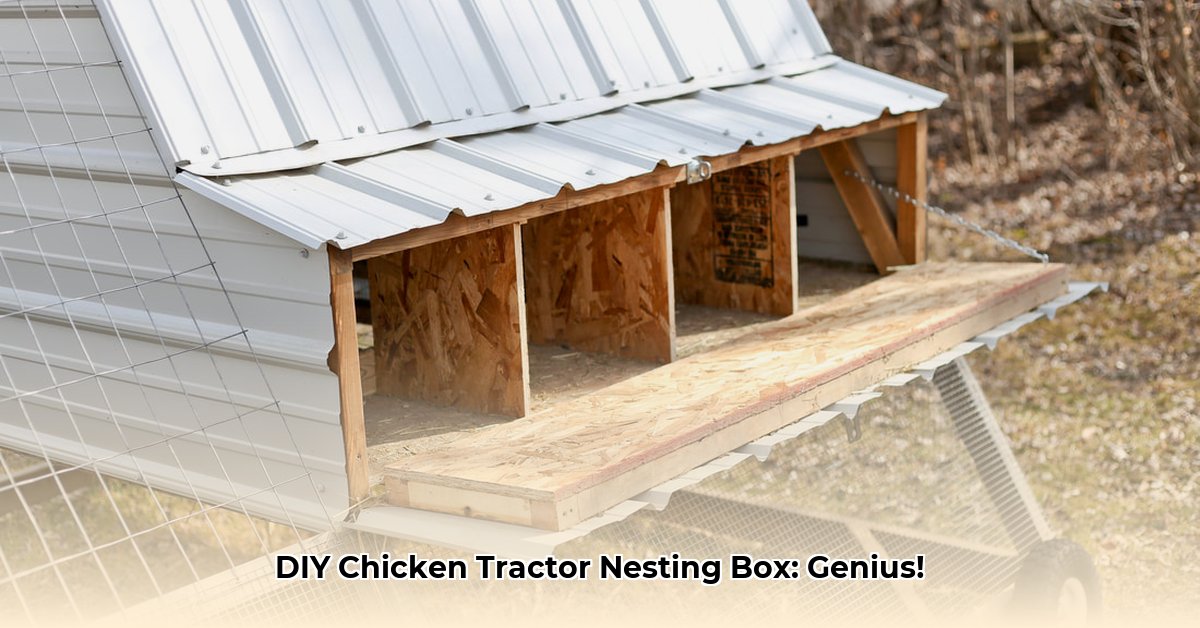
Building your own chicken tractor nesting box is a rewarding project that benefits both your hens and the environment. A comfortable nesting area leads to happier, healthier hens and more eggs – a win-win! This guide will walk you through designing and constructing a sustainable nesting box perfect for your mobile coop. For pre-built options, check out these chicken coop kits.
Choosing Sustainable Materials
The materials you select hugely impact your nesting box's lifespan and environmental footprint. Here are some eco-friendly options:
Recycled Plastic: Durable, weather-resistant, and readily available, recycled plastic offers a long-lasting and sustainable choice. While it might be slightly more expensive upfront, its longevity makes it a worthwhile investment. It’s also easy to clean and sanitize.
Bamboo: A rapidly renewable resource, bamboo is naturally strong and pest-resistant. However, for outdoor use, you'll need to treat it with a non-toxic, water-resistant sealant to protect it from the elements and prolong its lifespan.
Reclaimed Wood: Repurposing old wood is incredibly sustainable and adds character to your nesting box. Thoroughly inspect the wood for any harmful chemicals or rot before use, and consider applying a non-toxic sealant for added protection.
Material Comparison:
| Material | Advantages | Disadvantages |
|---|---|---|
| Recycled Plastic | Durable, weather-resistant, readily available, easy to clean | Potentially higher initial cost |
| Bamboo | Renewable, strong, pest-resistant, attractive | Requires treatment for outdoor durability |
| Reclaimed Wood | Sustainable, unique character, often affordable | Requires inspection for chemicals, may need treatment |
The best material depends on your budget, material availability, and personal preferences. Remember to prioritize non-toxic, environmentally friendly treatments if needed.
Designing the Ideal Nesting Box
A well-designed nesting box prioritizes hen comfort and easy egg collection. Consider these key design elements:
Size: Aim for approximately 12 inches x 12 inches x 12 inches (30cm x 30cm x 30cm) per nesting box. This provides ample space for hens to comfortably turn around and feel secure. More space is always better than less!
Egg Access: Incorporate a hinged lid or slanted roof for easy egg collection without disturbing your hens. This will save you time and prevent stress on your flock.
Ventilation: Proper ventilation prevents mold and mildew, crucial for a healthy nesting environment. Small holes or gaps in the design will suffice.
Placement: Position the box in a quiet, dark corner of the chicken tractor, away from drafts and high-traffic areas. Hens prefer privacy for laying. Is your hen's nesting box location impacting their egg-laying habits? This is a common issue among backyard poultry keepers.
Quantity: As a general guideline, provide one nesting box for every three to four hens. Overcrowding can lead to competition and stress. Observe your flock; if you notice hens fighting over nesting spots, adding another box might be necessary.
Building Your Nesting Box: A Step-by-Step Guide
This guide uses recycled plastic as an example, but the principles apply to other materials with slight adjustments. Always prioritize safety and wear appropriate protective gear.
Step 1: Measure and Cut: Accurately measure and cut your chosen material according to your chosen design. Precise cuts are crucial for a well-fitting box.
Step 2: Assemble the Box: Securely connect the cut pieces using screws and appropriate fasteners. Ensure all joints are tight and sturdy to create a robust structure. A sturdy box is vital for longevity and protection.
Step 3: Attach the Lid/Roof: Securely fasten the lid or roof. A well-secured lid is essential to protect eggs from the elements and potential predators. Consider adding hinges for easy opening.
Step 4: Add Bedding: Provide a comfortable nesting area by adding a layer of suitable bedding material like straw, wood shavings, or shredded paper (ensure it’s untreated). This will provide comfort and encourage your hens to use the box.
Step 5: Securely Attach to Tractor: Firmly attach the completed nesting box to the inside of your chicken tractor using sturdy brackets or screws.
Maintaining Your Nesting Box
Regular cleaning is vital for maintaining a healthy environment and preventing parasite buildup. Remove soiled bedding frequently and replace with fresh material. Aim for a complete box cleaning at least once a month. Regular cleaning reduces potential disease risks and ensures your hens remain healthy.
Key Takeaways
- Providing a comfortable and safe nesting environment is key to maximizing egg production and ensuring hen well-being.
- Building your own nesting box offers cost savings and allows for customized designs using sustainable materials, aligning with ethical and sustainable farming practices.
- Regular maintenance, including cleaning and bedding replacement, is essential for maintaining a healthy environment for your hens.
This comprehensive guide empowers you to build a sustainable and hen-approved nesting box for your chicken tractor, contributing to both your flock's happiness and your commitment to responsible farming. Remember, a happy hen is a productive hen!